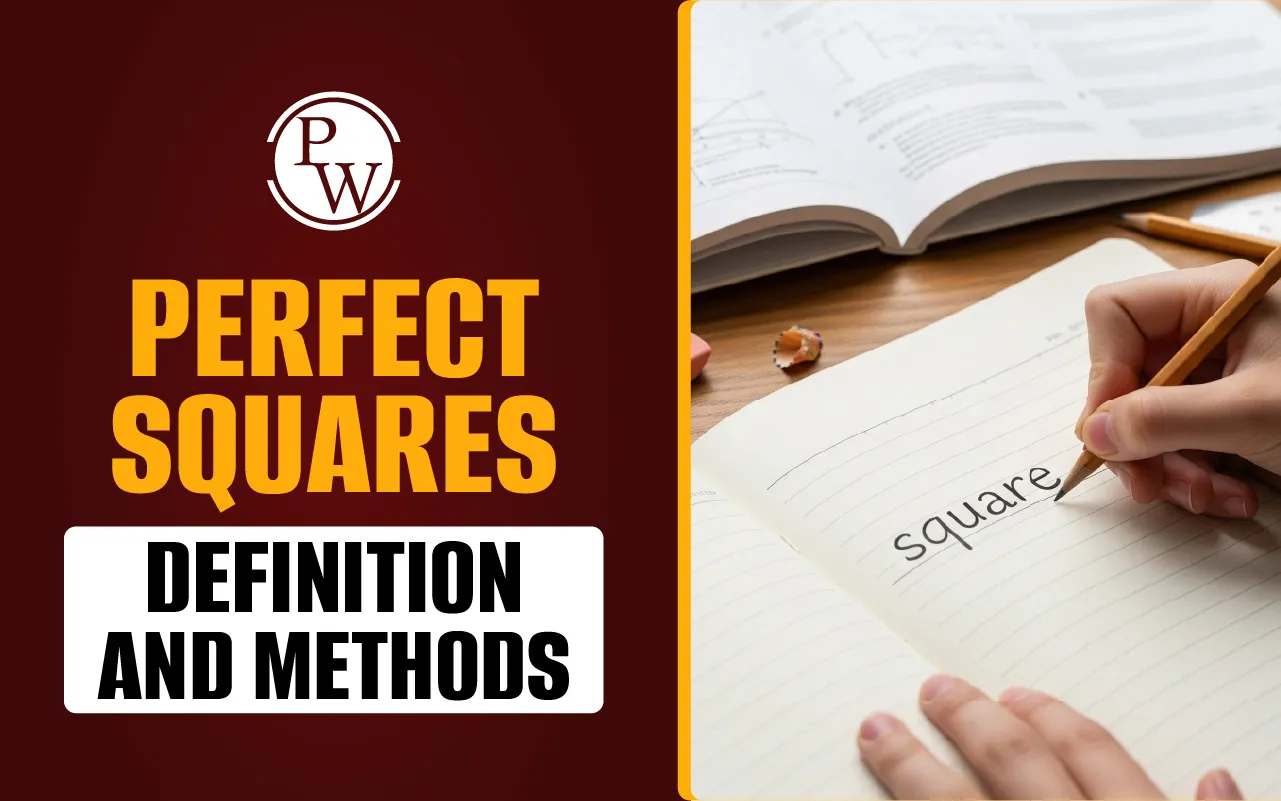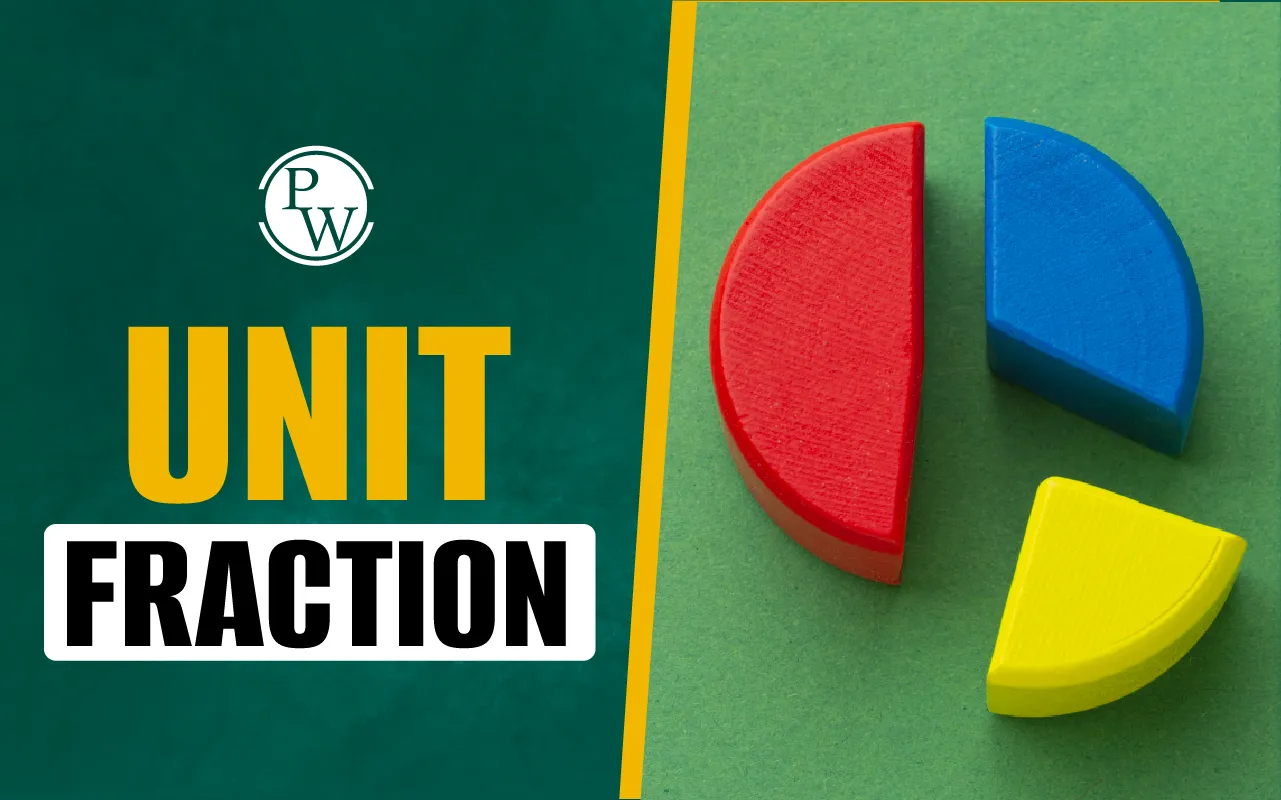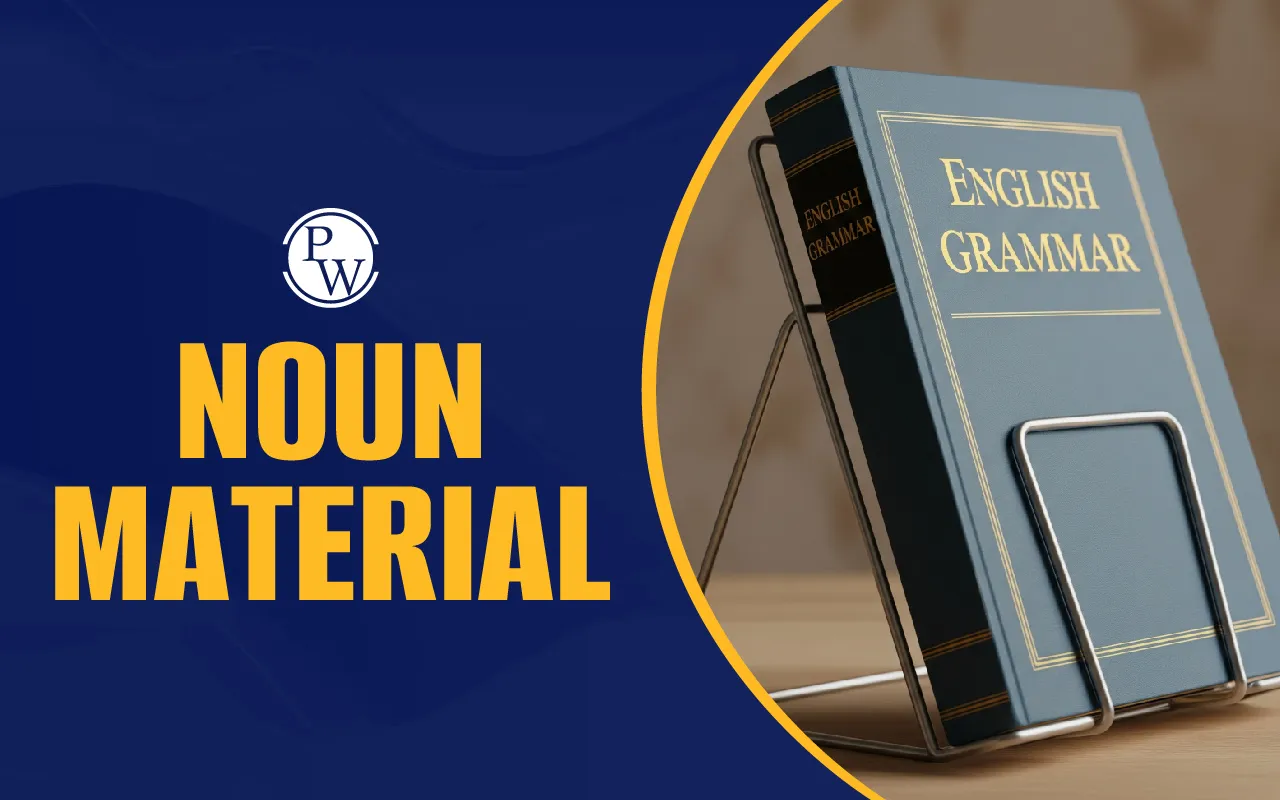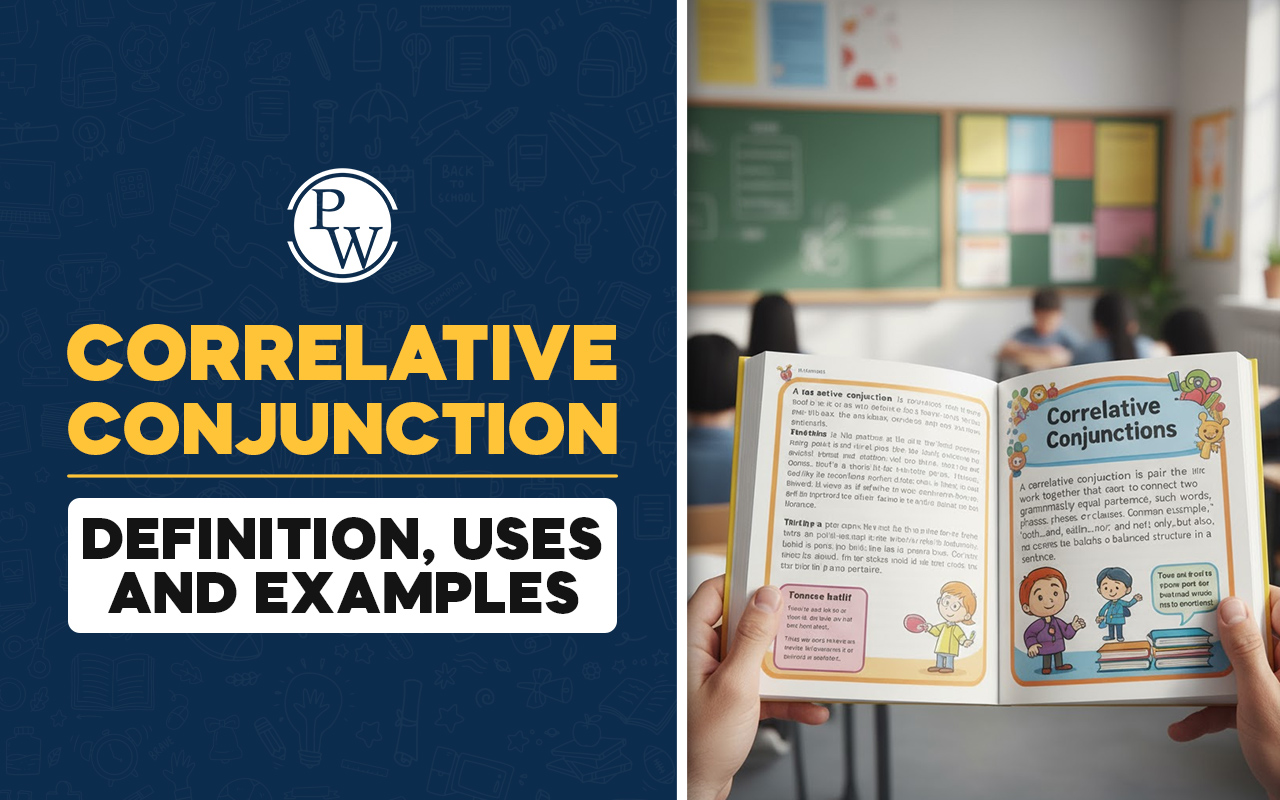
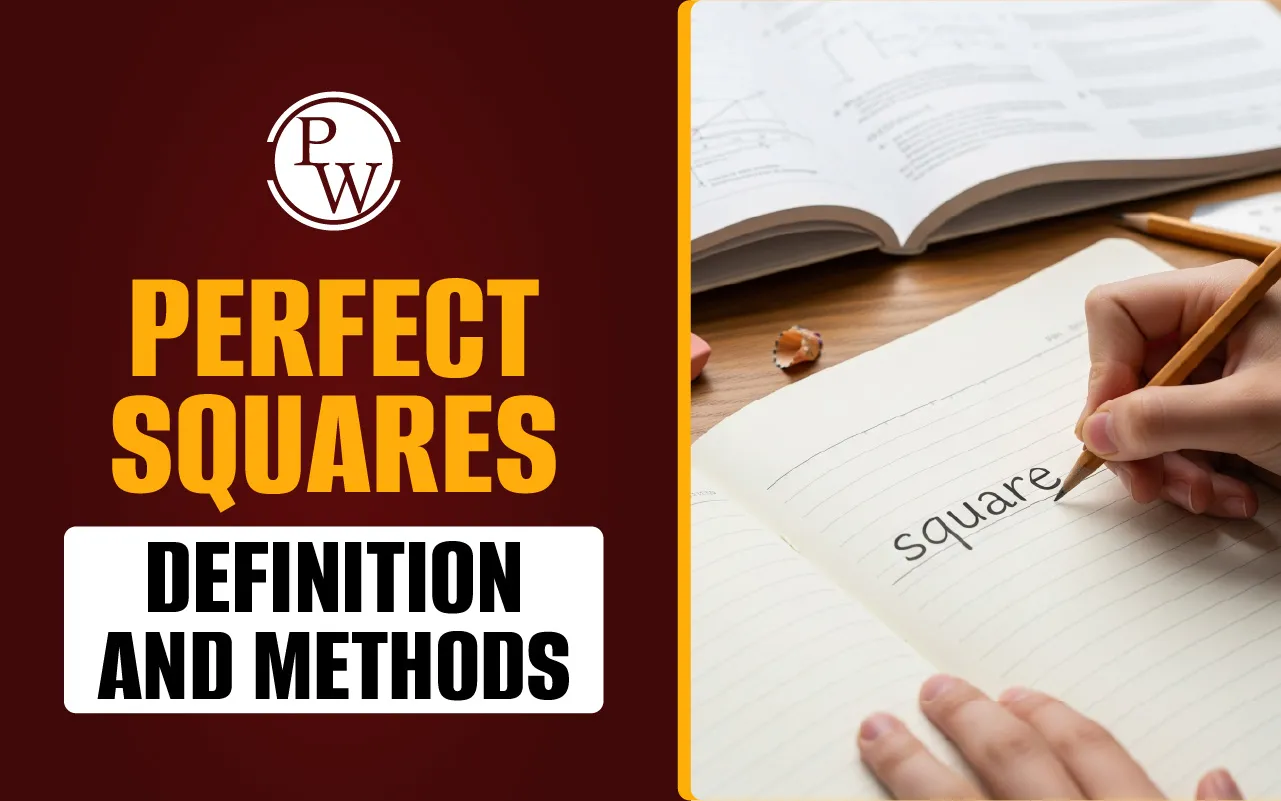
Perfect Squares: In maths, we learn about many types of numbers like even, odd, and prime. One particular type of number is known as a perfect square. These perfect square numbers are made by multiplying a whole number by itself. For example, 16 is a perfect square because 4 × 4 = 16. These numbers are easy to identify once we understand their pattern.
Keep reading to learn what is a perfect square and how to find these perfect square numbers. Students will also get to learn about perfect square roots and how to spot whether a number is a square number or not. Learning perfect squares can make it easier for them to solve many maths problems quickly and correctly.
Read More: Square Root
What is a Perfect Square?
Many students wonder, "what is a perfect square?" and how to identify it. As per the definition of perfect square, it is a number that has a complete square root. It means when we take the square root of that number, we get a whole number. For example, the square root of 49 is 7 because 7 × 7 = 49. So, 49 is a perfect square. But if we take a number like 50, its square root is not a whole number, so it is not a perfect square.
We can also understand perfect squares by using the shape of a square. A square has all sides equal, and its area is found by multiplying one side by itself. So, if the side of a square is 9 units, the area is 9 × 9 = 81. That 81 is a perfect square. Perfect square numbers are often written in the form of x², where x is a whole number like 1, 2, 3, and so on.
Properties of Perfect Squares
Perfect square numbers have some special qualities that make them different from other numbers. These properties can help students quickly identify if a number is a perfect square or not.
-
One interesting fact is that a perfect square always ends in 0, 1, 4, 5, 6, or 9. It will never end with digits like 2, 3, 7, or 8. For example, 25, 36, and 49 are perfect squares, but 42 or 87 cannot be.
-
Another property is about odd and even numbers. If a number is even, its perfect square will also be even. If the number is odd, the square will be odd too. Like 4 is even, and 4 × 4 = 16 is also even. But 3 is odd, and 3 × 3 = 9 is odd.
-
Perfect squares also have a special pattern with their factors. Most numbers have an even number of factors, but perfect squares have an odd number of factors. For example, 9 has three factors: 1, 3, and 9. This happens because one of the factors repeats (3 × 3 = 9).
-
Also, if we look at two perfect squares that come one after the other, like 1 and 4 or 4 and 9, the difference between them is always an odd number. For example, 4 − 1 = 3, 9 − 4 = 5, 16 − 9 = 7, and so on.
Read More: Average Formula in Maths
List of Perfect Squares
List of perfect squares from 1 to 100 outlined in the table below includes numbers that are made by multiplying whole numbers by themselves. These square numbers are easy to remember and can help students solve maths problems quickly. Learning the perfect square numbers from 1 to 100 helps in understanding patterns, solving square root questions, and doing faster calculations in exams.
|
List of Perfect Square Roots From 1 to 100 |
|||||||||
|
1² = 1 |
2² = 4 |
3² = 9 |
4² = 16 |
5² = 25 |
6² = 36 |
7² = 49 |
8² = 64 |
9² = 81 |
10² = 100 |
|
11² = 121 |
12² = 144 |
13² = 169 |
14² = 196 |
15² = 225 |
16² = 256 |
17² = 289 |
18² = 324 |
19² = 361 |
20² = 400 |
|
21² = 441 |
22² = 484 |
23² = 529 |
24² = 576 |
25² = 625 |
26² = 676 |
27² = 729 |
28² = 784 |
29² = 841 |
30² = 900 |
|
31² = 961 |
32² = 1024 |
33² = 1089 |
34² = 1156 |
35² = 1225 |
36² = 1296 |
37² = 1369 |
38² = 1444 |
39² = 1521 |
40² = 1600 |
|
41² = 1681 |
42² = 1764 |
43² = 1849 |
44² = 1936 |
45² = 2025 |
46² = 2116 |
47² = 2209 |
48² = 2304 |
49² = 2401 |
50² = 2500 |
|
51² = 2601 |
52² = 2704 |
53² = 2809 |
54² = 2916 |
55² = 3025 |
56² = 3136 |
57² = 3249 |
58² = 3364 |
59² = 3481 |
60² = 3600 |
|
61² = 3721 |
62² = 3844 |
63² = 3969 |
64² = 4096 |
65² = 4225 |
66² = 4356 |
67² = 4489 |
68² = 4624 |
69² = 4761 |
70² = 4900 |
|
71² = 5041 |
72² = 5184 |
73² = 5329 |
74² = 5476 |
75² = 5625 |
76² = 5776 |
77² = 5929 |
78² = 6084 |
79² = 6241 |
80² = 6400 |
|
81² = 6561 |
82² = 6724 |
83² = 6889 |
84² = 7056 |
85² = 7225 |
86² = 7396 |
87² = 7569 |
88² = 7744 |
89² = 7921 |
90² = 8100 |
|
91² = 8281 |
92² = 8464 |
93² = 8649 |
94² = 8836 |
95² = 9025 |
96² = 9216 |
97² = 9409 |
98² = 9604 |
99² = 9801 |
100² = 10 |
Tips to Identify Perfect Square Numbers
Many students often feel confused about whether a number is a perfect square or not. But instead of solving or checking every number by multiplying, there are some easy tricks and tips that can help to identify perfect square numbers.
Find the tips given below that make it simple to find out if a number is a perfect square just by observing its digits or patterns.
-
Look at the last digit: Perfect square numbers always end with 0, 1, 4, 5, 6, or 9.
If a number ends with 2, 3, 7, or 8, then it can never be a perfect square. For example: -
49 ends in 9 so it can be a perfect square (and it is).
-
67 ends in 7 so it cannot be a perfect square.
-
Count the zeros at the end: If a number ends with zeros, then check how many zeros it has.
-
If the number has an odd number of zeros at the end, it is not a perfect square. For example, 1000 (3 zeros): not a perfect square
-
If it has an even number of zeros, it might be a perfect square. For example, 400 (2 zeros) is a perfect square, while 300 (2 zeros) is not a perfect square.
-
Check the square root: Find the square root of the number.
-
If the square root is a whole number, then the number is a perfect square. For example, √81 = 9 (a perfect square).
-
If the square root is a decimal number, then it is not a perfect square. For example, √24 = 4.89 (not a perfect square).
These simple tips help students save time and avoid confusion while solving math problems involving square numbers and perfect square roots.
Read More: Dimensional Formula
What Are Perfect Square Roots?
Perfect square roots are the square roots of numbers that give a whole number as the answer. In simple words, when a number is multiplied by itself and gives a perfect square, that original number is called the perfect square root.
For example, 9 × 9 = 81, so the square root of 81 is 9. Since 9 is a whole number, it is a perfect square root.
-
Furthermore, perfect square roots are written using the √ symbol, like √36 = 6. If a number has a whole number as its square root, then it is a perfect square, and the root is a perfect square root.
-
For example, √4 = 2, √25 = 5, and √81 = 9 all are perfect square roots. But if we take a number like √2 or √3, the answers are not whole numbers. These are called imperfect square roots.
Knowing what perfect square roots are helps students understand both squares and roots in a better way. It also makes solving math problems in geometry, algebra, and mental maths much easier. Check out the list of square numbers and their perfect square roots from 1 to 100:
|
Perfect Square Roots from 1 to 100 |
|
|
Square Numbers |
Perfect Square Roots |
|
1 |
1 |
|
4 |
2 |
|
9 |
3 |
|
16 |
4 |
|
25 |
5 |
|
36 |
6 |
|
49 |
7 |
|
64 |
8 |
|
81 |
9 |
|
100 |
10 |
Method to Find Perfect Square Roots Using Prime Factorization
To find the perfect square roots of numbers, we can use the prime factorization method. This method helps us break the number into smaller parts and check if it forms perfect pairs. Here is the step-by-step explanation of this method:
-
Step 1: Find the prime factors of the number (break the number into smaller prime numbers).
-
Step 2: Make pairs of the same prime numbers.
-
Step 3: Take one number from each pair and multiply them together. The final answer will be the square root.
For example:
-
Find the square root of 324.
-
The prime factorization of 324 is: 2 × 2 × 3 × 3 × 3 × 3
-
Now, make pairs: (2 × 2), (3 × 3), (3 × 3)
-
Take one number from each pair: 2 × 3 × 3 = 18
-
So, √324 = 18.
-
Find the square root of 98.
-
Prime factorization of 98 is: 2 × 7 × 7
-
Only one pair: (7 × 7), but 2 is left alone.
-
Since all factors do not form pairs, 98 is not a perfect square.
-
So, √98 = 7√2, which is not a whole number.
How to Identify Perfect Squares Using the Square Root
One of the simple methods to check if a number is a perfect square is by finding its square root. If the square root is a whole number, then the number is a perfect square. But if the square root is a decimal number, then it is not a perfect square.
For example, √49 = 7. Since 7 is a whole number, 49 is a perfect square. But if we take √24, the answer is around 4.89, which is not a whole number. So, 24 is not a perfect square. Hence, to quickly identify perfect squares, students can check:
-
If the answer has no decimal, it is a perfect square.
-
If the answer has a decimal, then the number is not a perfect square.
Also Read: Rational Numbers
Speed Up Your Child’s Calculation Skills with Mental Maths Classes by CuriousJr
Does your child take too long to solve simple sums or struggle with topics like perfect squares, multiplication tables, or number patterns? This generally happens when children rely too much on fingers or written steps instead of building strong mental maths skills.
Building strong mental maths skills at an early stage helps children solve questions faster, stay confident in exams, and improve their overall performance. That’s exactly what CuriousJr’s Mental Maths Online Classes are designed for.
-
These classes teach fun and easy tricks to solve math questions without using tools.
-
With features like interactive live sessions, two-teacher support, visual learning tools, and regular practice help, children enjoy learning while improving speed and accuracy.
-
The daily performance tracking and homework support also keep parents involved in their child’s progress.
Book a demo class now and see how mental maths classes can help your child become quicker, sharper, and more confident in math.
Perfect Squares FAQs
What are perfect square numbers?
What are perfect square roots?
What is the perfect square formula?
What is the square root of 49?
What are the next two perfect squares after 16?

